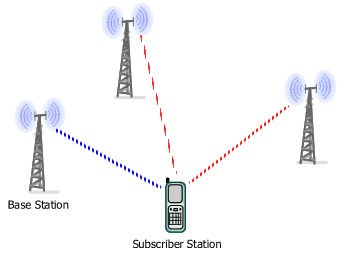Handoff mechanism in Mobile WiMAX
For implementing a mobile network, a handoff mechanism must be
defined to maintain uninterrupted user communication session
during his/her movement from one location to another. Handoff
mechanism handles subscriber station (SS) switching from one Base
Station (BS) to another. Different handoff techniques have
been developed. In general, they can be divided into soft handoff and
hard handoff.

Picture. Soft Handoff
A SS maintains multiple connections. Delay is very minimal
Soft handoff is used in voice-centric cellular networks such as
GSM or CDMA. It
uses a make-before-break approach whereas a connection to the next BS
is established before a SS leaves an ongoing connection to a BS.
This technique is suitable to handle voice and other
latency-sensitive services such as Internet multiplayer game and
video conference. When used for delivering data
traffic (such as web browsing and e-mail), soft handoff
will result in lower spectral efficiency because this type of
traffic is bursty and does not require continues handover from one
BS to another.

Picture. Hard Handoff
A SS maintains a connection to a single BS at any given time.
Mobile WiMAX has been designed from the outset as a broadband
technology capable of delivering triple play services (voice,
data, video). However, a typical Mobile WiMAX network is
supposedly dominated by delay-tolerant data traffic. Voice in
Mobile WiMAX is packetized (what is called VoIP) and treated as
other types of IP packets except it is prioritized. Hard handoff (HHO) is therefore used in Mobile WiMAX. In hard handoff, a
connection with a BS is ended first before a SS switches to another
BS. This is known as a break-before-make approach. Hard handoff is
more bandwidth-efficient than soft handoff, but it causes longer
delay. A network-optimized hard handoff
mechanism was developed for Mobile WiMAX to keep a handoff delay under 50 ms.
|